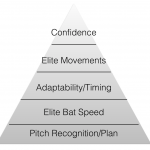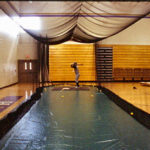The how, why, and when of throwing a change up in high school baseball
It is my opinion that a good straight change up (or circle change with arm side run and sink) is one of the most valuable pitches you can teach a young player, but it is often the third pitch to come together behind the fastball and breaking ball.
The goal of the change up
Obviously, an ideal outcome of any pitch is to get a swing and miss. Change ups are often swing and miss pitches when throw away from an opposite handed hitter (LHP vs. RHH or RHP vs. LHH) or down and in to a same handed hitter.
But perhaps the change up’s greatest strength is the ability to induce weak contact. With pitch counts now in all NFHS states, minimizing pitches is a big deal, especially to starting pitchers wanting to go deep into the game. A good change up can get a hitter out on their front foot and induce weak contact, likely ending the at bat quickly and often times with an out.
What a change up is not (when it is least effective)
While this should not be taken as a hard and fast rule, the change-up is generally not a put-a-way pitch with two strikes. Because one of its greatest strengths is inducing weak contact, you would often rather throw a swing and miss pitch like a breaking ball that breaks out of the zone, a fastball that can freeze the hitter, or a high fastball that can get a swing and miss.
The one exception would be a pitcher who has a lot of horizontal movement on their change up and can start it on the outside corner to an opposite handed hitter and fade if off the edge. This can be especially effective after an inside fastball.
Free video tutorial on throwing a change up
Why the change up is effective
A properly thrown change up will not be a change up off the pitcher’s fastball velocity, it will be a change up off of the pitcher’s fastball arm speed. If you throw an 80mph fastball and a 72mph change up, the change up will only be effective if the pitcher’s arm speed matches the 80mph fastball. If the arm speed says 72 and the pitch velocity is 72, they’ve just thrown a BP fastball!
It is for this reason, though, that the change up is so effective. The hitter SHOULD see the same arm slot, same arm speed, and roughly the same spin out of the pitcher’s hand as their fastball. Often by the time their eye tracks the change in velocity, it is too late.
When to throw the change up
Any time should be sitting on a fastball is a great time to throw a change up. Many times this is in even counts 0-0, 1-1, after a breaking ball thrown for a ball early in the count, or in a hitters count (1-0, 2-0, 2-1, 3-1).
Obviously, throwing the change up in a hitter’s count takes a lot of confidence in the pitch and will require pitchers to feel comfortable with the feel f the pitch. Some days they may be able to throw it, some days they may not be able to. One of the best ways to gain confidence in the pitch is to throw it often in a variety of different counts.
Another great time to throw a change up is in a close and late, high anxiety situation. The higher the hitter’s heart beat, the more anxious they are, the more likely they are to swing through a change up or get out in front of it for weak contact.
Last season, we were up two in the bottom of the 7th with two outs and the bases loaded. Our opponents had one of their better hitters up who was a left handed hitter. We had a right handed pitcher on the mound. We started him off with a fastball for a strike, then threw a curveball for a ball. The next pitch was a fastball that he was right on and fouled it off. I could tell the hitter was trying to slow his heart rate down, but taking deep breaths and stepping out of the box. We threw one more fastball, that missed up, but he was jumpy at it.
I called a change up in this situation because it was close and late, I could tell he was anxious, and he had just seen two fastballs including a fastball for a ball. All of those would indicate that a fastball was coming next. We executed the change up and their hitter was well out in front of it and swung through it.
Free video tutorial on throwing a change up
Two different change ups?
While it is not necessary to throw different change ups, it can be useful. If you throw both a two and four seam fastballs, you may want to develop both a two and four seam change up. The worst combination is if you only throw a four seam fastball and throw only a two seam change up. If this is the case, hitters will be able to recognize the pitch by its spin.
It may also be useful to develop a change up that cuts glove side, instead of runs arm side. This change up can be used against same handed hitters by starting it middle away and running it to the outside corner, or starting it on the outside edge and running it off the plate.
They also may be able to develop two different amounts of run on their change up. One may be more of a straight change, where they don’t try to pronate their wrist as much at release. This could be useful against a same handed hitter when trying to throw the change up away.
The second type of change up may be one where they pronate their wrist a bit more and create a screwball action/spin. This one will need to rely on the movement since it will likely look different out of the hand by having more side spin. This change up can be very useful against opposite handed hitters on the outer edge of the plate, or against same handed hitters down
Tips for training the change up
The change up is very much a “feel” pitch. There probably isn’t a cue you can give a pitcher that will magically give them that feel. They need to throw it and throw it a lot.
Here are tips for developing a change up:
- Throw it a lot when playing catch. Maybe designate one day as change up day, where they throw mostly change ups as they are playing catch.
- Throw it every third pitch when doing drill work. Setting this standard for your pitchers in practice will “force them” to throw the change up more,
- Play long toss with it from 90-120 feet. IMO, this is one of the best ways to learn feel for the change up. You will get to mess around with different releases and that should push the arm speed up around the fastball.
- Even if you don’t have success with it early, keep throwing it in games. This is perhaps the toughest thing to do. Many times a pitcher will struggle with the change up and cast it aside, then no real development takes place.
- Video fastballs and change ups. Remember, the two should look almost identical and you should not be able to tell the pitch type by arm angle, arm speed or spin. Likewise, you can throw into a net a few feet away and have someone try to determine if it was a fastball or change up by seeing only the first few feet of the pitch.
- Know the velocity different of the change up and fastball. The ideal difference is about 7-10mph as long as the arm speed closely matches the fastball. If the arm speed, arm slot and spin really closely match the fastball, they may be able to get away with less than 7mph difference.
Free video tutorial on throwing a change up
More from my site
 CCA Podcast 141 – Addressing the challenges of simulating the game in practice
CCA Podcast 141 – Addressing the challenges of simulating the game in practice CCA Podcast Episode 002: Playing College Baseball Part 2
CCA Podcast Episode 002: Playing College Baseball Part 2 CCA Podcast 235 – The Hitting Pyramid – Adaptability and Timing
CCA Podcast 235 – The Hitting Pyramid – Adaptability and Timing College baseball needs pitch count limits and mandatory rest!!! … or does it?
College baseball needs pitch count limits and mandatory rest!!! … or does it?  CCA Podcast 204 – Dirt ball reads, base running efficiency, and taking over a program
CCA Podcast 204 – Dirt ball reads, base running efficiency, and taking over a program Measurement Tools for Indoor Baseball Tryouts
Measurement Tools for Indoor Baseball Tryouts
 Posted by Kyle Nelson
Posted by Kyle Nelson- Posted in Pitching
 Oct, 09, 2018
Oct, 09, 2018 No Comments.
No Comments.
Elite members login here
Check out what’s New/Hot!
Recognizing, Diagnosing, and Fixing Common Hitting Flaws eCourse The 3 metrics we tested on Blast motion sensors this year Sneak Peek Inside an Elite Q and A The batting practice continuum Elite Member’s area table of contents 50+ “Chaos” hitting drills
5 sample Chaos hitting drills FREE
Mental Skills and Culture Building The hitting pyramid Welcome Elite Member, Trey! Ideas for a pitcher first practice 12 week bat speed improvement plan Make plans this offseason to have your team playing their best baseball at the end of the year” Top 5 hitting drills to translate practice skill to game performanceHow we used Blast Motion sensors with a team in 2019
What to do if your hitters are overmatched Welcome Elite Member, Tommy! Setting your baserunners up for success Welcome Elite Member, Mike! A consulting call with Elite Member Matt FREE Web Clinic: Developing Athletic, Consistent, Extraordinary Infielders
 Coach Kyle Nelson
Coach Kyle Nelson